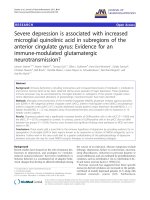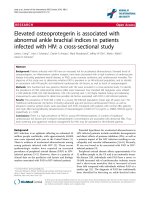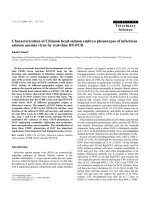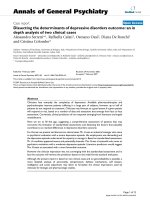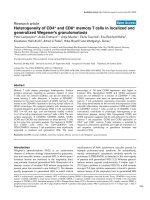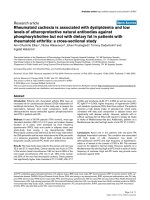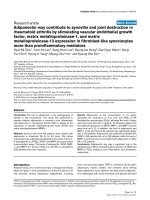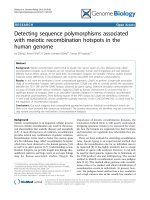Báo cáo y học: "Preoperative statin is associated with decreased operative mortality in high risk coronary artery bypass patients" pot
Bạn đang xem bản rút gọn của tài liệu. Xem và tải ngay bản đầy đủ của tài liệu tại đây (404.81 KB, 5 trang )
RESEARC H ARTIC LE Open Access
Preoperative statin is associated with decreased
operative mortality in high risk coronary artery
bypass patients
James A Magovern, Robert J Moraca
*
, Stephen H Bailey, David A Dean, Kathleen A Simpson, Thomas D Maher,
Daniel H Benckart, George J Magovern Jr
Abstract
Background: Statins are widel y prescribed to patients with atherosclerosis. A retrospective datab ase analysis was
used to examine the role of preoperative statin use in hospital mortality, for patients undergoing isolated coronary
artery bypass grafting (CABG.)
Methods: The study population comprised 2377 patients who had isolated CABG at Allegheny General Hospital
between 2000 and 2004. Mean age of the patients was 65 ± 11 years (range 27 to 92 years). 1594 (67%) were
male, 5% had previous open heart procedures, and 4% had emergency surgery. 1004 patients (42%) were being
treated with a statin at the time of admission . Univariate, bivariate (Chi
2
, Fisher’s Exact and Student’s t-tests) and
multivariate (stepwise linear regression) analyses were used to evaluate the association of statin use with mortality
following CABG.
Results: Annual prevalence of preoperative statin use was similar over the study perio d and averaged 40%.
Preoperative clinical risk assessment demonstrated a 2% risk of mortality in both the statin and non-statin groups.
Operative mortality was 2.4% for all patients, 1.7% for statin users and 2.8% for non-statin users (p < 0.07). Using
multivariate analysis, lack of statin use was found to be an independent predictor of mortality in high-risk patients
(n = 245, 12.9% vs. 5.6%, p < 0.05).
Conclusions: Between 2000 and 2004 less than 50% of patients at this institution were receiving statins before
admission for isolated CABG. A retrospective analysis of this cohort provides evidence that preoperative statin use
is associated with lower operative mortality in high-risk patients.
Introduction
The use of 3-hydroxy-3-methyl-glutaryl coenzyme A
reductase inhibitors (statins) has been shown to reduce
death, myocardial infarction and stroke in pati ents with
elevated serum cholesterol and in those with near nor-
mal serum cholesterol levels [1]. The mechanism of this
improvement is likely multifactorial, with some benefit
attributed to lipid lowering effects and some to lipid-
independent (pleiotropic) properties. Rece ntly, evidence
has accumulated that statins have beneficial effects on
various portions of the clinical pathway that leads to
atherosclerosis and cardiovascular events. These effects
include downregulation of the inflammatory cascade [2],
stabilization of the endothelial cel l [3], attenuation of
oxidative damage [4], decreasing thrombotic r isk and
possibly plaque stabilization [5]. The use of statins has
steadily increased over time, but these drugs remain
under utilized, relative to the larger population at risk
for atherosclerosis. Patients who require coronary artery
bypass grafting (CABG) represent a small segm ent of
the entire population of patients with coronary artery
disease. Many CABG patients have been treated with
statinsasoutpatientsbeforeCABG,butasizeable
group present with no previous statin therapy. This
study was undertaken to examine the efficacy of preo-
perative statin use on in-hospital mortality after CABG
surgery.
* Correspondence:
Department of Cardiovascular and Thoracic Surgery, Allegheny General
Hospital, Pittsburgh, PA, USA
Magovern et al. Journal of Cardiothoracic Surgery 2010, 5 :8
/>© 2010 Magovern et al; licensee BioMed Central Ltd. This is an Open Access article distributed under the terms of the Creative
Commons Attribution License ( which permits unrestricted use, distri bution, and
reprodu ction in any medium, provided the original work is proper ly cited.
Patients and Methods
Data Collection
Data were retrospectively abstracted from the institu-
tion’s cardiac surger y database, which includes over 500
variables describing patient history, pre-, intra- and
post-operative data and events and selected laboratory
and functional testing results. Data from every patient
who undergoes a major cardiac procedure is recorded
on a standardized form and entered into the database
by trai ned datab ase staff during the admission and
immediately following discharge. Data is collected under
a waiver of consent from the Allegheny General Insti tu-
tional Review Board.
AGH Clinical Risk Score
As part of surgical consultation all patients are assigned
a numerical clinical risk score (CRS) based on preopera-
tive variables, including factors such as age, left ventri-
cular function, comorbid diseases and laboratory studies.
The risk score model is validated and has been
described fully in a previous publication [6]. A recent
study has confirmed the efficacy of the Magovern CRS
in comparison to other well known risk assessment
models [7]. The CRS ranges between 0 and 20 with a
lower score predicting lower operative mort alit y. In this
study, high risk patients were defined as those with a
CRS of 9 or above (predicted mortality of at least 6%).
Major postoperative morbidity was defined as the occur-
rence of any of the following complications: inotrope
use for greater than 24 hours, acute myocardial infarc-
tion, cerebrovascular accident, respiratory failure, new
onset renal failure, deep sternal wound infection or reo-
peration for bleeding/tamponade.
Operative Technique
Standard anesthesia and surgical techniques were uti-
lized for all patients. Based upon preoperative beliefs
and pathology, patients were offered conventional cardi-
opulmonary bypass or when appropriate; an off pump
technique. Conventional cardiopulmonary bypass uti-
lized systemic heparinization (300 mg/kg heparin sul-
fat e) to maintain an activated clotting time (ACT) >450
seconds. Off pump cardiac surgery utilized 100 mg/kg
loading dose of heparin with a goal to maintain an ACT
>300 seconds. Moderate hypothermia 34 Celsius was
used in all cardiopulmonary bypass operations and
patients were re-warmed to 36 Celsius prior to
discontinuing the cardiopulmonary bypass. Cold blood
cardioplegia was utilized for induction and maintenance.
Patient Population
The study population comprised all patients who under-
went isolated CABG surgery betw een January 1, 2000
and December 31, 2004. This study period was chosen
because it afforded a large, comparable cohort o f
patients in both the statin and non-statin treated
groups. Patients were considered t o be in the “ statin”
group if they were taking statins at the time of admis-
sion or they were started during the admission prior to
surgery. No data regardingthespecificdrugordose
was obtained.
Statistical Analysis
Data are expressed as mean ± standard deviation (con-
tinuous variables) or inciden ce and percent of the rele-
vant group. The study endpoint was defined as all cause
in-hospital mortality. Bivariate analyses were performed
to examine associations between preoperative status
variables and this endpoint, using St udent’ st-test,
Mann-Whitney rank sums test, Chi-square anal ysis and
Fisher’ s exact test, as appropriate for co ntinuous and
dichotomous variables. Variables with significant (p <
0.15) bivariate evidence of association with the endpoint
were then evaluated usi ng stepwise logistic regression to
determine which of the variables contributed to a multi-
variate predict ion model for in-hospital mortality.
BMDP Statistical Sof tware, release 7 was used to per-
form all analyses.
Results
Both the proportion of preoperat ive stat in usage and the
predicted mortality score for coronary bypass patients
were similar over the course of the study period (Table 1).
Table 2 illustrates the prevalence of relevant pre- and
intra-operative variables in the overall population and in
the statin and no statin study groups. There was no differ-
ence in incidence of any major preoperative co-morbidity.
Mean left ventricular ejection fraction (LVEF) was 47.4 ±
13.8 in the no-statin group and 48.6 ± 13.6 in the statin
group. Distribution of LVEF values (0-19%, 20-29%, 30-
39%, 40-49%, 50% and higher) was a lso similar. The no-
statin group was statistically older from the statin group
(65.4 vs. 64.8, p = 0.02), however this difference has negli-
gible clinical relevance.
Table 1 Preoperative statin usage and clinical risk score in CABG patients by year of surgery
Year: 2000 2001 2002 2003 2004
Statin Usage (%) 246/647 (38%) 220/523 (42%) 204/447 (46%) 181/423 (43%) 153/337 (45%)
Mean CRS 4.6 ± 3.7 4.5 ± 3.2 4.7 ± 3.7 4.0 ± 3.0 4.5 ± 3.2
CRS: Allegheny General Hospital cardiac surgery clinical risk score.
Magovern et al. Journal of Cardiothoracic Surgery 2010, 5 :8
/>Page 2 of 5
Patients undergoing a redo open heart procedure were
more likely to be receiving statin treatment, likely
reflectingmorefocusedcardiaccarefollowingthepre-
vious surgery. Surgical indices of grafts performed, and
cross-clamp and cardiopulmonary bypass times did not
differ between groups. 13.4% of patient s und erwent off -
pump CABG, with no difference noted between the sta-
tin and non-statin groups. There were no differences
regarding intubation time, ICU duration and hospital
stay. The results of bivariate analysis betwee n mortality
rate and relevant preoperative variables are shown in
Table 3. Each of these variables, with the exception o f
non-insulin diabetes mellitus, was used for the multi-
variate assessment. Multivariate analysis was used to
determine which variables were independently asso-
ciated with decreased mortality in the study population.
Variables with a significant independent contribution to
mortality risk are illustrated in Table 4. When consider-
ing the entire population there was no significant contri-
bution of statins to operat ive risk. However the absence
of statin treatment was associated with an increase in
mortality in the subset of high risk patients with an esti-
mated risk of mortality of 6% and greater.
Multivariate regression analysis was also performed
using composite postoperative major morbidity as an
endpoint. Statin usage was not shown to have a signifi-
cant impact on composite major morbidity in this lim-
ited assessment.
Discussion
Statins are one of the most effective medicines intro-
duced in the past 25 years. Nonetheless they are still
relatively under prescribed, especially in patients without
symptomatic or obvious ather osclerosis and those with-
out sever e hypercholesterolemia. Recently, our knowl-
edge regarding the biology of the non-lipid lowering, or
pleiotropic effects of statins has rapidly expanded.
Simultaneously, a number of recent reports have sug-
gested a salutary effect of statins on perioperative mor-
tality for patients undergoing CABG.
Clark, et al, reported a retrospective database study
from the Medica l Universi ty of South Carolina covering
3829 patients between 1996 and 2002 [8]. Only 1044/
3829 patients received preoperative therapy (28%). In a
propensity matched analysis they demo nst rated signifi-
cant association between preoperative statin therapy and
lower 30 day mortality and morbidity. These findings
paralleled those of an earlier study by Pan et al from the
Texas Heart Institute [9]. This study evaluated 1563
patients who underwent CABG with CPB at a single
institution. Multivariate analysis was used to show a
50% reduction in the risk of perioperative (30 day) death
in those patients who received statins preoperatively.
The use of statins preoperatively was not associated
with a lower incidence o f post-operative complications.
In a propensity matched subgroup analysis statin ther-
apy was associated with a significantly lower risk of the
composite endpoint including death and stroke (but not
death alone).
Collard, et al, showed similar results in a large inter-
national, multi-institutional study [10]. The primary
study was a longitudinal analysis of 5436 pa tients at 70
centers undergoing CABG. The stati n study was a post-
hoc retrospective a nalysis using this database and
showed reduced early cardiac mortality in p at ient s
receiving statins who underwent elective CABG (0.3%
vs.1.4%).Further,thediscontinuationofstatinspost-
operatively was as sociated with increased all-cause hos-
pital mortality (2.6% vs. 0.6%) co mpared to t hose who
had statin therapy maintained.
Statin use in the current study averaged 42% (range 38
- 46%) over the five-year period of 2000-2004. The rela-
tively low prevalence may represent a referral bias in
that our center is a primary angioplasty referral center.
Consequently, many patients have a new diagn osis of
coronary artery disease and the statin is not always
started before operation, especially in the urgent or
Table 2 Study Population and results of bnivariate
analysis of statin groups
All Statin No Statin
Patients 2377 1004 1373
Age (years) 65.4 ± 10.7 64.8 ± 10.9 65.8 ± 10.3
a
Off-Pump CABG 321 (13.4%) 167 (6.9%) 154 (6.4%)
CAB Grafts 2.9 ± 1.0 2.8 ± 1.0 2.9 ± 1.1
AXC (minutes) 72.4 ± 25.1 73.0 ± 25.3 71.9 ± 24.9
CPB (minutes) 103 ± 33 104 ± 33 102 ± 32
Non-elective procedure 1376 (57%) 568 (57%) 808 (59%)
Redo Procedure 125 (5.3%) 66 (6.6%) 59 (4.3%)
b
Female gender 719 (30.2%) 298 (29.7%) 421 (30.7%)
Congestive heart failure history 316 (13.3%) 133 (13.2%) 183 (13.3%)
Cardiomegaly 94 (4.0%) 41 (4.1%) 53 (3.9%)
Atrial arrhythmia history 133 (5.6%) 43 (4.3%) 87 (6.3%)
Body mass index < 25 340 (14.3%) 132 (13.1%) 208 (15.1%)
Preoperative AMI 428 (18.0%) 167 (16.6%) 261 (19.0%)
COPD 402 (16.9%) 184 (18.3%) 218 (15.9%)
Peripheral vascular disease 340 (14.3%) 144 (14.3%) 196 (14.3%)
Stroke history 144 (6.1%) 56 (5.6%) 88 (6.4%)
Renal failure 77 (3.2%) 28 (2.8%) 49 (3.6%)
Tobacco past/current 1101 (46.3%) 499 (49.7%) 602 (43.8%)
IDDM 260 (10.9%) 124 (12.4%) 136 (9.9%)
In-hospital death 56 (2.4%) 17 (1.7%) 39 (2.8%)
c
AMI: acute myocardial infarction, a: p = 0.02; b: p = 0.01; c: p =0.07.
Magovern et al. Journal of Cardiothoracic Surgery 2010, 5 :8
/>Page 3 of 5
emergent situation. Begin ning in 2005 our isolated
CABG population demonstrated an increase in preo-
perative statin use to greater than 80%.
Themostimportantobjectiveofthisstudywasto
determineiftheuseofpreoperativestatintherapyis
associated with reduced postoperative mortality. In each
of the 5-years of the study, the mortality rate was lower
in the group of patients exposed to statins preopera-
tively (range 26 - 60%.) In total, the net effect was to
reduce mortality from 2.8% to 1.7%. The effect was seen
in all groups, but was most notable in the high risk
cohort (12.9% vs. 5.6%, p < 0.05), where the predicted
mortality was 6% and higher.
This study was not designed to expl ain how statins
exert their salutary effect. Nonetheless, a number of
hypotheses are generated. Our group [11] and others
[12] have recently shown that patients undergoing heart
surgery who have elevated risk based on standard preo-
perative variables (age, left ventricular dysfunction, co-
morbid disease) have evidence of ongoing inflammation
manifested by elevated levels of inflammatory mediators
such as interleukin-6 (IL-6) and C-reactive protein
(CRP). Statins have been shown to ameliorate the
inflammatory cas cade in a num ber of models and these
properties ma y confer protection from the inflammatory
response induced by open heart surgery. This may
explain the more pronounced protective effect of statins
in our high risk cohort.
Statins have also been shown in clinical trials to be
associated with decreased mortality when administered
in the f irst 24 hours after acute myocardial infarction
[13,14]. This may be the result of their potential ability
to limit infarct size, as demonstrated i n animal models
of acute infarction [15]. These properties may contribute
to the beneficial effect associated with CABG and would
help to explain the more marked effect in high risk
patients, many of whom require urgent or emergent sur-
gery in the setting of acute ischemia or infarction.
The current study, in addition to all t he other studies
on preoperative statin use, is retrospective and nonran-
domized. This introduces the issue of selection bias and
other confounding variables. The statistical analysis
minimizes this possibility, but it cannot eliminate this
issue completely. Further, we do not have specific
Table 4 Preoperative variables identified as independent
predictors of in-hospital mortality following CABG
surgery
Coefficient p value
All Patients
Atrial arrhythmia history 0.84 < 0.001
Congestive heart failure history 0.87 < 0.001
Age (years) 0.06 < 0.001
Redo procedure 1.20 0.009
Preoperative AMI 0.84 0.005
Insulin dependent diabetes 0.85 0.009
Tobacco past/current 0.77 0.024
Female gender 0.56 0.066
High Risk Patients
Insulin dependent diabetes 1.10 0.070
Preoperative statin use -1.07 0.030
AMI: acute myocardial infarction.
Table 3 Results of bnivariate analysis of mortality rates associated with selected preoperative variables
Variable: Present Not Present p value
Preoperative statin 17/1004 (1.7%) 39/1373 (2.8%) 0.07
Preoperative AMI 19/428 (4.4%) 37/1949 (1.9%) 0.002
Preoperative anemia 18/437 (4.1%) 38/1940 (2.0%) 0.007
Body mass index < 25 14/340 (4.1%) 42/2037 (2.1%) 0.02
Non insulin dependent diabetes 10/500 (2.0%) 46/1877 (2.5%) 0.55
Insulin dependent diabetes 14/260 (5.4%) 42/2117 (2.0%) 0.006
Chronic obstructive pulmonary disease 16/402 (4.0%) 40/1975 (2.0%) 0.02
Stroke history 6/144 (4.2%) 50/2233 (2.2%) 0.14
Peripheral vascular disease 12/340 (3.5%) 44/2037 (2.2%) 0.12
Renal failure history 5/77 (6.5%) 51/2300 (2.2%) 0.02
Atrial arrhythmia history 14/133 (10.5%) 42/2244 (1.9%) < 0.001
Congestive heart failure history 21/316 (6.7%) 35/2061 (1.7%) < 0.001
Tobacco past/current 33/1101 (3.0%) 23/1276 (1.8%) 0.06
Female gender 25/719 (3.5%) 31/1658 (1.9%) 0.02
Cardiomegaly 8/94 (8.5%) 48/2283 (2.1%) < 0.001
Redo procedure 9/125 (7.2%) 47/2252 (2.1%) < 0.001
Survivors In-hospital death
Age (years) 65.3 ± 10.7 71.5 ± 8.9 < 0.001
AMI: acute myocardial infarction.
Magovern et al. Journal of Cardiothoracic Surgery 2010, 5 :8
/>Page 4 of 5
information regardi ng the specific statin, dose, duration
or cholesterol lowering efficacy. There may be important
factors with regard to dosage and duration of therapy
that impact the benefit of st atins in this patient popula-
tion that we can not identify with this study. Nonethe-
less, we have shown a consistent reduction i n
perioperative mortality in patients being treated with
statins, particularly those with elevated operative risk.
While placebo controlled trials will likely not be possi-
ble, further study of the underlying mechanisms of these
effects are needed.
Acknowledgements
Presented at the 43
rd
Annual Meeting of the Society of Thoracic Surgery,
San Diego, CA, January 30, 2007.
Authors’ contributions
JAM performed the initial study design and oversight of the manuscript
preparation. RJM contributed to the statistical analysis, designed and wrote
the tables and performed all the major and minor revisions of the
manuscript. SAB assisted in study design, manuscript preparation, and
presentation at national meeting. DAD assisted in study design and
statistical analysis. KAS developed the database and performed statistical
analysis. DHB assisted in study design and manuscript preparation. TDM
assisted in manuscript preparation, initial data analysis and study design.
GJM Jr. performed the initial study design and authored key sections of the
manuscript. All authors read and approved the final manuscript.
Competing interests
The authors declare that they have no competing interests.
Received: 1 November 2009
Accepted: 24 February 2010 Published: 24 February 2010
References
1. Third Report on the National Cholesterol Education Program (NCEP)
Expert Panel on Detection, Evaluation, and Treatment of High Blood
Cholesterol in Adults (Adult Treatment Panel III) final report. Circulation
2002, 06:3143-3421.
2. Kinlay S, Egido J: Inflammatory biomarkers in stable atherosclerosis. Am J
Cardiol 2006, 98(11A):2P-8P.
3. Walter DH, Rittig K, Bahlmann FH, Kirchmair R, Silver M, Murayama T,
Nishimura H, Losordo DW, Asahara T, Isner JM: Statin therapy accelerates
re-endothelialization: a novel effect involving mobilization and
incorporation of bone marrow-derived endothelial progenitor cells.
Circulation 2002, 105:3017-3024.
4. Sotirios T: Oxidative biomarkers in the diagnosis and prognosis of
cardiovascular disease. Am J Cardiol 2006, 98(11A):9P-17P.
5. Libby P, Sasiela W: Plaque stabilization: can we turn theory into
evidence?. Am J Cardiol 2006, 98(11A):26P-33P.
6. Magovern JA, Sakert T, Magovern GJ, Benckart DH, Burkholder JA,
Liebler GA, Magovern GJ Sr: A model that predicts morbidity and
mortality after coronary artery bypass graft surgery. J Am Coll Cardiol
1996, 28(5):1147-53.
7. Nilsson J, Algotsson L, Höglund P, Lührs C, Brandt J: Comparison of 19
pre-operative risk stratification models in open heart surgery. Eur Heart J
2006, 27:867-874.
8. Clark LL, Ikonomidis JS, Crawford FA Jr, Crumbley A, Kratz JM, Stroud MR,
Woolson RF, Bruce JJ, Nicholas JS, Lackland DT, Zile MR, Spinale FG:
Preoperative statin treatment is associated with reduced postoperative
mortality and morbidity in patients undergoing cardiac surgery: an 8-
year retrospective cohort study. J Thorac Cardiovasc Surg 2006, 131:679-85.
9. Pan W, Pintar T, Anton J, Lee VV, Vaughn WK, Collard CD: Statins are
associated with a reduced incidence of perioperative mortality after
coronary artery bypass graft surgery. Circulation 2004, 110:II-45-II-49.
10. Collard CD, Body SC, Shernan SK, Wang S, Mangano DT: Preoperative
statin therapy is associated with reduced cardiac mortality after
coronary artery bypass graft surgery. J Thorac Cardiovasc Surg 2006,
132:392-400.
11. Magovern JA, Singh D, Teekell-Taylor L, Scalise D, McGregor W:
Preoperative clinical factors are important determinants of the
inflammatory state before and after heart surgery. ASAIO J 2007,
53(3):316-9.
12. Podgoreanu MV, White WD, Morris RW, Mathew JP, Stafford-Smith M,
Welsby IJ, Grocott HP, Milano CA, Newman MF, Schwinn DA: Inflammatory
gene polymorphisms and risk of postoperative myocardial infarction
after cardiac surgery. Circulation 2006, 114(1 Suppl):I275-I281.
13. Wright RS, Bybee K, Miller WL, Laudon DA, Murphy JG, Jaffe ASl: Reduced
risks of death and CHF are associated with statin therapy administered
acutely within the first 24 hours of AMI. Int J Cardiol 2006, 108:314-319.
14. Ray KK, Cannon CP, Ganz P: Beyond lipid lowering: what have we learned
about statins from the acute coronary syndrome trials. Am J Cardiol 2006,
98(11A):18P-25P.
15. Tiefenbacher CP, Kapitza J, Dietz V, Lee CH, Niroomand F: Reduction of
myocardial infarct size by fluvastatin. Am J Physiol Heart Circ Physiol 2003,
285:H59-64.
doi:10.1186/1749-8090-5-8
Cite this article as: Magovern et al.: Preoperative statin is associated
with decreased operative mortality in high risk coronary artery bypass
patients. Journal of Cardiothoracic Surgery 2010 5:8.
Submit your next manuscript to BioMed Central
and take full advantage of:
• Convenient online submission
• Thorough peer review
• No space constraints or color figure charges
• Immediate publication on acceptance
• Inclusion in PubMed, CAS, Scopus and Google Scholar
• Research which is freely available for redistribution
Submit your manuscript at
www.biomedcentral.com/submit
Magovern et al. Journal of Cardiothoracic Surgery 2010, 5 :8
/>Page 5 of 5
